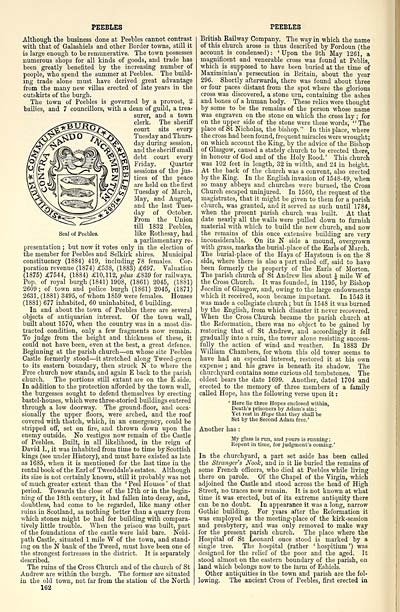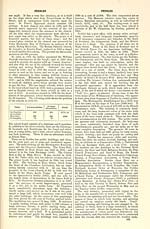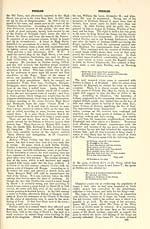Ordnance gazetteer of Scotland > Volume 5
(252) Page 162 - PEE
Download files
Complete book:
Individual page:
Thumbnail gallery: Grid view | List view

Seal of Peebles.
PEEBLES
Although the business done at Peebles cannot contrast
■with that of Galashiels and other Border towns, still it
is large enough to be remunerative. The town possesses
numerous shops for all kinds of goods, and trade has
been greatly benefited by the increasing number of
people, who spend the summer at Peebles. The build-
ing trade alone must have derived great advantage
from the many new villas erected of late years in the
•outskirts of the burgh.
The town of Peebles is governed by a provost, 2
bailies, and 7 councillors, with a dean of guild, a trea-
surer, and a town
clerk. The sheriff
court sits every
Tuesday and Thurs-
day during session,
and the sheriff small
debt court every
Friday. Quarter
sessions of the jus-
tices of the peace
are held on the fii'st
Tuesday of March,
May, and August,
and the last Tues-
day of October.
From the Union
till 1832 Peebles,
like Rothesay, had
a parliamentary re-
presentation ; but now it votes only in the election of
the member for Peebles and Selkirk shires. Municipal
constituency (1884) 419, including 78 females. Cor-
poration revenue (1874) £538, (1883) £697. Valuation
(1875) £7544, (1884) £10,112, plus £839 for railways.
Pop. of royal burgh (1841) 1908, (1861) 2045, (1881)
2609; of town and police burgh (1861) 2045, (1871)
2631, (1881) 3495, of whom 1859 were females. Houses
(1881) 677 inhabited, 60 uninhabited, 6 building.
In and about the town of Peebles there are several
objects of antiquarian interest. Of the town wall,
built about 1570, when the country was in a most dis-
tracted condition, only a few fragments now remain.
To judge from the height and thickness of these, it
could not have been, even at the best, a great defence.
Beginning at the parish church — on whose site Peebles
Castle formerly stood — it stretched along Tweed-green
to its eastern boimdary, then struck N to where the
Free church now stands, and again E back to the parish
church. The portions stUl extant are on the E side.
In addition to the protection afforded by the town wall,
the burgesses sought to defend themselves by erecting
bastel-houses, which were three-storied buildings entered
through a low doorway. The ground-floor, and occa-
sionally the upper floors, were arched, and the roof
covered with thatch, which, in an emergency, could be
stripped off, set on fire, and thrown down upon the
enemy outside. No vesfnges now remain of the Castle
of Peebles. Built, in all likelihood, in the reign of
David I., it was inhabited from time to time by Scottish
kings (see under History), and must have existed as late
as 1685, when it is mentioned for the last time in the
rental book of the Earl of Tweeddale's estates. Although
its size is not certainly known, still it probably was not
of much greater extent than the ' Peel Houses ' of that
period. Towards the close of the 17th or in the begin-
ning of the 18th century, it had fallen into decay, and,
doubtless, had come to be regarded, like many other
ruins in Scotland, as nothing better than a quarry from
which stones might be had for building with compara-
tively little trouble. When the prison was built, part
of the foundations of the castle were laid bare. Neid-
path Castle, situated 1 mile W of the town, and stand-
ing on the N bank of the Tweed, must have been one of
the strongest fortresses in the district. It is separately
described.
The ruins of the Cross Church and of the church of St
Andrew are within the burgh. The former are situated
in the old town, not far from the station of the North
162
PEEBLES
British Railway Company. The way in which the name
of this church arose is thus described by Fordoun (the
account is condensed) : ' Upon the 9th May 1261, a
magnificent and venerable cross was found at Peblis,
which is supposed to have been buried at the time of
Maximinian's persecution in Britain, about the year
296. Shortly afterwards, there was found about three
or four paces distant from the spot where the glorious
cross was discovered, a stone urn, containing the ashes
and bones of a human body. These relics were thought
by some to be the remains of the person whose name
was engraven on the stone on which the cross lay ; for
on the upper side of the stone were these words, " The
place of St Nicholas, the bishop. " In this place, where
the cross had been found, frequent miracles were wrought;
on which account the King, by the advice of the Bishop
of Glasgow, caused a stately church to be erected there,
in honour of God and of the Holy Rood.' This church
was 102 feet in length, 32 in width, and 24 in height.
At the back of the church was a convent, also erected
by the King. In the English invasion of 1548-49, when
so many abbeys and churches were burned, the Cross
Church escaped uninjured. In 1560, the request of the
magistrates, that it might be given to them for a parish
church, was granted, and it served as such until 1784,
when the present parish church was built. At that
date nearly all the walls were pulled down to furnish
material with which to build the new church, and now
the remains of this once extensive building are very
inconsiderable. On its N side a mound, overgrown
with grass, marks the burial-place of the Earls of March.
The burial-place of the Hays of Haystoun is on the S
side, where there is also a part raded off, said to have
been formerly the property of the Earls of Morton.
The parish church of St Andrew lies about J mile W of
the Cross Church. It was founded, in 1195, by Bishop
Jocelin of Glasgow, and, owing to the large endowments
which it received, soon became important. In 1543 it
was made a coUegiate church ; but in 1548 it was burned
by the English, from which disaster it never recovered.
When the Cross Church became the parish church at
the Reformation, there was no object to be gained by
restoring that of St Andrew, and accordingly it feU
gradually into a ruin, the tower alone resisting success-
fully the action of wind and weather. In 1883 Dr
William Chambers, for whom this old tower seems to
have had an especial interest, restored it at his own
expense ; and his grave is beneath its shadow. The
churchyard contains some curious old tombstones. The
oldest bears the date 1699. Another, dated 1704 and
erected to the memory of three members of a family
called Hope, has the following verse upon it :
' Here lie three Hopes enclosed within.
Death's prisoners by Adam's sin ;
Yet rest in Hope that they shall be
Set by the Second Adam free.'
Another has :
My glass is run, and yours is running ;
Repent in time, for judgment's coming.'
In the churchyard, a part set aside has been called
the Stranger's Nook, and in it lie buried the remains of
some French officers, who died at Peebles while living
there on parole. Of the Chapel of the Virgin, which
adjoined the Castle and stood across the head of High
Street, no traces now remain. It is not known at what
time it was erected, but of its extreme antiquity there
can be no doubt. In appearance it was a long, narrow
Gothic building. For years after the Reformation it
was employed as the meeting-place of the kirk-session
and presbytery, and was only removed to make way
for the present parish church. The place where the
Hospital of St Leonard once stood is marked by a
single tree. The hospital (rather ' hospitium ') was
designed for the relief of the poor and the aged. It
stood almost on the eastern boundary of the parish, on
land which belongs now to the farm of Eshiels.
Other antiquities in the town and parish are the fol-
lowing. The ancient Cross of Peebles, first erected in
PEEBLES
Although the business done at Peebles cannot contrast
■with that of Galashiels and other Border towns, still it
is large enough to be remunerative. The town possesses
numerous shops for all kinds of goods, and trade has
been greatly benefited by the increasing number of
people, who spend the summer at Peebles. The build-
ing trade alone must have derived great advantage
from the many new villas erected of late years in the
•outskirts of the burgh.
The town of Peebles is governed by a provost, 2
bailies, and 7 councillors, with a dean of guild, a trea-
surer, and a town
clerk. The sheriff
court sits every
Tuesday and Thurs-
day during session,
and the sheriff small
debt court every
Friday. Quarter
sessions of the jus-
tices of the peace
are held on the fii'st
Tuesday of March,
May, and August,
and the last Tues-
day of October.
From the Union
till 1832 Peebles,
like Rothesay, had
a parliamentary re-
presentation ; but now it votes only in the election of
the member for Peebles and Selkirk shires. Municipal
constituency (1884) 419, including 78 females. Cor-
poration revenue (1874) £538, (1883) £697. Valuation
(1875) £7544, (1884) £10,112, plus £839 for railways.
Pop. of royal burgh (1841) 1908, (1861) 2045, (1881)
2609; of town and police burgh (1861) 2045, (1871)
2631, (1881) 3495, of whom 1859 were females. Houses
(1881) 677 inhabited, 60 uninhabited, 6 building.
In and about the town of Peebles there are several
objects of antiquarian interest. Of the town wall,
built about 1570, when the country was in a most dis-
tracted condition, only a few fragments now remain.
To judge from the height and thickness of these, it
could not have been, even at the best, a great defence.
Beginning at the parish church — on whose site Peebles
Castle formerly stood — it stretched along Tweed-green
to its eastern boimdary, then struck N to where the
Free church now stands, and again E back to the parish
church. The portions stUl extant are on the E side.
In addition to the protection afforded by the town wall,
the burgesses sought to defend themselves by erecting
bastel-houses, which were three-storied buildings entered
through a low doorway. The ground-floor, and occa-
sionally the upper floors, were arched, and the roof
covered with thatch, which, in an emergency, could be
stripped off, set on fire, and thrown down upon the
enemy outside. No vesfnges now remain of the Castle
of Peebles. Built, in all likelihood, in the reign of
David I., it was inhabited from time to time by Scottish
kings (see under History), and must have existed as late
as 1685, when it is mentioned for the last time in the
rental book of the Earl of Tweeddale's estates. Although
its size is not certainly known, still it probably was not
of much greater extent than the ' Peel Houses ' of that
period. Towards the close of the 17th or in the begin-
ning of the 18th century, it had fallen into decay, and,
doubtless, had come to be regarded, like many other
ruins in Scotland, as nothing better than a quarry from
which stones might be had for building with compara-
tively little trouble. When the prison was built, part
of the foundations of the castle were laid bare. Neid-
path Castle, situated 1 mile W of the town, and stand-
ing on the N bank of the Tweed, must have been one of
the strongest fortresses in the district. It is separately
described.
The ruins of the Cross Church and of the church of St
Andrew are within the burgh. The former are situated
in the old town, not far from the station of the North
162
PEEBLES
British Railway Company. The way in which the name
of this church arose is thus described by Fordoun (the
account is condensed) : ' Upon the 9th May 1261, a
magnificent and venerable cross was found at Peblis,
which is supposed to have been buried at the time of
Maximinian's persecution in Britain, about the year
296. Shortly afterwards, there was found about three
or four paces distant from the spot where the glorious
cross was discovered, a stone urn, containing the ashes
and bones of a human body. These relics were thought
by some to be the remains of the person whose name
was engraven on the stone on which the cross lay ; for
on the upper side of the stone were these words, " The
place of St Nicholas, the bishop. " In this place, where
the cross had been found, frequent miracles were wrought;
on which account the King, by the advice of the Bishop
of Glasgow, caused a stately church to be erected there,
in honour of God and of the Holy Rood.' This church
was 102 feet in length, 32 in width, and 24 in height.
At the back of the church was a convent, also erected
by the King. In the English invasion of 1548-49, when
so many abbeys and churches were burned, the Cross
Church escaped uninjured. In 1560, the request of the
magistrates, that it might be given to them for a parish
church, was granted, and it served as such until 1784,
when the present parish church was built. At that
date nearly all the walls were pulled down to furnish
material with which to build the new church, and now
the remains of this once extensive building are very
inconsiderable. On its N side a mound, overgrown
with grass, marks the burial-place of the Earls of March.
The burial-place of the Hays of Haystoun is on the S
side, where there is also a part raded off, said to have
been formerly the property of the Earls of Morton.
The parish church of St Andrew lies about J mile W of
the Cross Church. It was founded, in 1195, by Bishop
Jocelin of Glasgow, and, owing to the large endowments
which it received, soon became important. In 1543 it
was made a coUegiate church ; but in 1548 it was burned
by the English, from which disaster it never recovered.
When the Cross Church became the parish church at
the Reformation, there was no object to be gained by
restoring that of St Andrew, and accordingly it feU
gradually into a ruin, the tower alone resisting success-
fully the action of wind and weather. In 1883 Dr
William Chambers, for whom this old tower seems to
have had an especial interest, restored it at his own
expense ; and his grave is beneath its shadow. The
churchyard contains some curious old tombstones. The
oldest bears the date 1699. Another, dated 1704 and
erected to the memory of three members of a family
called Hope, has the following verse upon it :
' Here lie three Hopes enclosed within.
Death's prisoners by Adam's sin ;
Yet rest in Hope that they shall be
Set by the Second Adam free.'
Another has :
My glass is run, and yours is running ;
Repent in time, for judgment's coming.'
In the churchyard, a part set aside has been called
the Stranger's Nook, and in it lie buried the remains of
some French officers, who died at Peebles while living
there on parole. Of the Chapel of the Virgin, which
adjoined the Castle and stood across the head of High
Street, no traces now remain. It is not known at what
time it was erected, but of its extreme antiquity there
can be no doubt. In appearance it was a long, narrow
Gothic building. For years after the Reformation it
was employed as the meeting-place of the kirk-session
and presbytery, and was only removed to make way
for the present parish church. The place where the
Hospital of St Leonard once stood is marked by a
single tree. The hospital (rather ' hospitium ') was
designed for the relief of the poor and the aged. It
stood almost on the eastern boundary of the parish, on
land which belongs now to the farm of Eshiels.
Other antiquities in the town and parish are the fol-
lowing. The ancient Cross of Peebles, first erected in
Set display mode to: Large image | Transcription
Images and transcriptions on this page, including medium image downloads, may be used under the Creative Commons Attribution 4.0 International Licence unless otherwise stated. ![]()
| Gazetteers of Scotland, 1803-1901 > Ordnance gazetteer of Scotland > Volume 5 > (252) Page 162 - PEE |
|---|
| Permanent URL | https://digital.nls.uk/97386974 |
|---|
| Attribution and copyright: |
|
|---|---|

